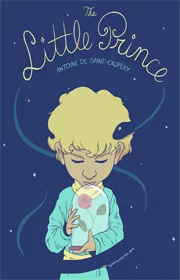
“The Little Prince” is a timeless novella written by Antoine de Saint-Exupéry. The story follows the narrator, a pilot stranded in the Sahara Desert, who encounters a young prince from a distant asteroid. As the Little Prince shares his extraordinary experiences and encounters with inhabitants of other asteroids, the narrative explores themes of friendship, love, and the complexities of human nature. Through whimsical adventures and poignant conversations, the story imparts profound lessons about the importance of seeing the world with a childlike wonder and cherishing the essential qualities that make life meaningful. Rich in allegory and symbolism, “The Little Prince” has captivated readers of all ages and continues to be a cherished and thought-provoking classic.
Read The Little Prince Flipbook:
Listen to The Little Prince Audiobook:
Title: The Little Prince
Author: Antoine de Saint-Exupéry
Genre: Children’s literature, allegorical fiction
Publication Year: 1943
Plot: The story revolves around a pilot stranded in the Sahara Desert who befriends a young prince from a tiny asteroid.
Themes: Friendship, love, imagination, human nature, and the importance of viewing the world through a child’s perspective.
Narrative Style: The narrative combines a simple, heartfelt storytelling style with whimsical illustrations drawn by the author himself.
Popularity: Translated into numerous languages, “The Little Prince” is one of the most-translated and best-selling books globally.
Legacy: A beloved classic, the book is celebrated for its timeless lessons and continues to inspire readers of all ages.
Origins: Antoine de Saint-Exupéry, the author and illustrator of “The Little Prince,” wrote and drew the story while in exile in the United States during World War II.
Dedication: The book is dedicated to Saint-Exupéry’s friend, Léon Werth. The dedication reads, “To Léon Werth when he was a little boy.”
Asteroid B-612: In the story, the Little Prince comes from Asteroid B-612. This fictional asteroid’s number was deliberately chosen to sound scientific, adding a touch of realism to the fantasy.
Inspiration from Saint-Exupéry’s Life: The author, a pioneering aviator, drew on his own experiences as a pilot for some of the themes and elements in the book.
Record-Breaking Sales: “The Little Prince” is one of the best-selling books in the world, with over 140 million copies sold and translations into numerous languages.
Illustrations: Saint-Exupéry’s own illustrations in the book are an integral part of its charm and have become iconic.
Cultural Impact: The story has inspired numerous adaptations, including stage productions, ballets, operas, and animated films, contributing to its enduring cultural legacy.
Timelessness: Despite being classified as a children’s book, “The Little Prince” is cherished by readers of all ages for its profound and universal themes.
Missing Plane Mystery: Antoine de Saint-Exupéry, who was also a pioneering aviator, mysteriously disappeared in 1944 during a reconnaissance mission in World War II, adding an air of intrigue to his life and the legend of “The Little Prince.”
International Celebrations: April 6th is celebrated as “The Little Prince Day” in honor of the author’s birth, encouraging readers worldwide to embrace the spirit of the story.